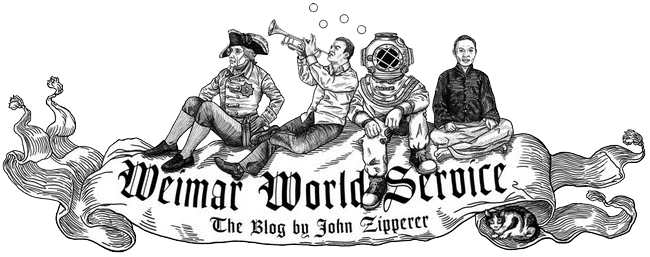
Produced for a century stretching from 1844 to 1944, Fliegende Blätter was a weekly satirical magazine published in Munich. If you don't read German, you can nonetheless get a sense of the magazine's style, attitude and quality by looking at these images (click on the image to see it enlarged). What Punch was to Britain, Fliegende Blätter was to Germany.

"Fliegende Blätter" is German for "flying sheets" or "flying papers." The initial thing that I noticed when I saw my first Fliegende Blätter was the gorgeous logo across the top of the first page. Ornate, over-the-top, fanciful, that logo adorned every cover until almost the end of its run, when it was replaced by a boring, non-fanciful, standard typeset logo (just one of the millions of things that the Nazis ruined).
The second thing to attract the reader's attention is the artwork. There is a lot of it, on every page of the publication, and the cartoons and other illustrations were drawn by some of the leading artists of the day.

The third thing is the typeface of the copy. Unusually fancy and overdone for modern tastes, it was once common for entire magazines and books to be published with that typeface. It may look like it'd be too difficult to read, but after a couple sentences, the modern reader (assuming he or she reads German) gets the hang of the two or three confusing letters and can read it as well as boring old Helvetica or Times New Roman. Personally, I love it. I think the more we strip down text and design, the more our magazines and books look like there was no attention paid to them and they were just done as economically as possible.
 That's obviously my own odd personal bias, but I do think the typeface used in Fliegende Blätter, along with the fantastic artwork, makes it look like every page had a great deal of care and talent poured into it. (Though, for all I know, they were slapped together on deadline by a small staff half-drunk on local Munich beer. If so, they worked well drunk.)
That's obviously my own odd personal bias, but I do think the typeface used in Fliegende Blätter, along with the fantastic artwork, makes it look like every page had a great deal of care and talent poured into it. (Though, for all I know, they were slapped together on deadline by a small staff half-drunk on local Munich beer. If so, they worked well drunk.)These days when venerable (and not-so-much) magazines are closing up shop left and right, it's nice to discover a great magazine that lasted a century, and even then only died because of a world war and a totalitarian dictator. And that's the way a proud satirical publication should die.

The pages illustrating this blog posting are from copies of the magazine that I own. But a great many complete copies of Fliegende Blätter are digitized and available for free online viewing from the University of Heidelberg.

No comments:
Post a Comment